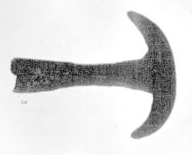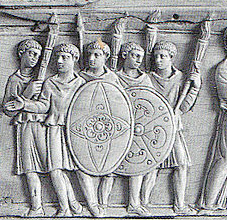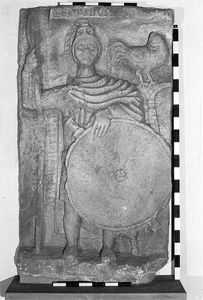
This page created 14 April 2014, and last modified: 21 November 2015 (Lepontius drawing replaced by photo)

The Ociavani is listed (98/9.29 in Ingo Maier's numbering scheme) as the 9th of the 12 legiones palatinae in the Magister Peditum's infantry roster; it is assigned (102/5.79) to his Italian command, as the Octavani. Its shield pattern (92#10), as found in various manuscripts under the label (92.k) Ociavani (but Octavani in B), is shown below:

The shield pattern is white with a red boss; the boss has a white centre bisected vertically with a red strip. The main field is charged with four red morel-like patterns at the 3, 6, 9, and 12 o'clock positions.
Given its name, the Octavani is evidently (part of) the old Legio VIII Augusta Pia Fidelis Constans, dating back to Julius Caesar's day, and formerly based as Argentoratum (modern Strasbourg). Judging by an inscription (CIL 13.11538) mentioning (at least part of) the legion at Etzgen in northern Switzerland dating to 371 AD, it had apparently been partially or entirely moved away from Strasbourg before being drafted into the Magister Peditum's Italian command; the legion is also know to have contributed a detachment to garrison Divitia on the east bank of the Rhine across from Colonia Augusta (Cologne) in the 4th century. Note that there is a frontpiece illustrating a Comes Argentoratensis in the Notitia, but the command appears to have been rendered defunct at some point, as he is not listed as controlling any troops, towns, or officers; the only thing he is listed as controlling is the Tractus argentoratensis.
The position of the Octavani in the list of the units assigned to the Italian command (102/5.53ff) seems to indicate that it was a comitatenses unit when the Notitia was first drawn up (since it there comes after the command's auxilia palatina units, and not before), but was later promoted to the palatine status it is recorded having in the Magister Peditum's infantry roster. Six of the 12 palatine legions in the western empire appear to be such recently upgraded units judging by their anomalous positioning in the lists of the field commands they are assigned to. This is somewhat surprising, because their positioning in the illustrations section correctly corresponds to their position in the Magister Peditum's roster, and illustrations cannot be updated as easily as text, and the Magister Peditum's Italian command list seems to bear many indications of being modified even more recently than that of his infantry roster. This would imply that when the Italian list was modified, it was not replaced in toto, but amendments were, at least in some cases, appended to it, in the manner of the US Constitution.
The shield pattern is very similar to that of the Vesontes (102/5.185), a legio comitatenses assigned to the "Comes" Hispenias. A comparison, using the patterns given in the Parisian manuscript, makes this obvious:

Perhaps a unit from Vesontio (modern Besancon in France) was brigaded with a detachment of the Eighth legion at some point in the 4th century, or perhaps it was a detachment of the Eighth itself that was stationed there and became the Vesontes. I am not aware of any epigraphic evidence for Roman units in Besancon, so if someone could fill me in on what is known of the Roman military history of Besancon, I'd be grateful!
The morel-shaped emblems that make up the shield pattern bring to mind the business end of a military "turf cutter" (the Latin word for which is unknown, and which re-enactors suspect was used for some other job, because it does a poor job of cutting turf); the photo below shows one excavated from Newstead in Scotland:

Taken from this book published in 1911, and now in the public domain.
On the other hand, they are also not too dissimilar from the pelte-shaped decorative elements often found as variations of the usually-angular supporters flanking tabula ansata. That shown below was found at Corbridge (RIB 1137).

Photo taken by M.C. Bishop, and used under CCA 2.0 license. The red colouring is a modern addition.
Tabula ansata were not only used on shield covers in the days of the principate to identify the (sub-)unit the shield belonged to, but could also be found as shield decorations themselves, as shown in several of the metope of the Tropaeum Traiani from Adamclisi. It is possible these decorative elements are behind the morels found on the shield of the Octavani, although the the fact there are four rather than two would have to be explained, perhaps by way of symmetry. This can be found on a shield borne by one of the soldiers on the Brescia Casket, a 4th century ivory box depicting Christian themes, as shown below:

Photo by RobyBS89, and dedicated to the public domain.
Below is a copy in the archaeological museum in Strasbourg of the gravestone of one; the original was found in Strasbourg in 1737 and destroyed in World War 2. Lepontius appears to have been a member of the Legio VIII in the 4th century. No shield pattern is indicated, but the fact he has a round shield, as opposed to oval, is interesting.

Photo by M.C. Bishop, and used under CCA 2.0 license.

Return to the Notitia alphabetical unit list page.
Return to my Notitia index page.